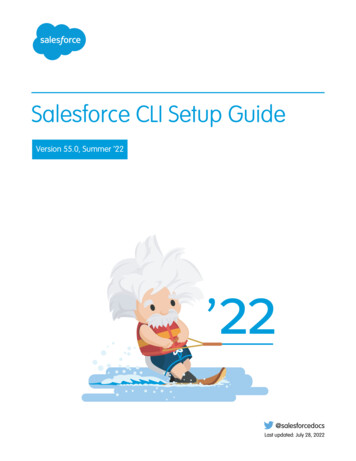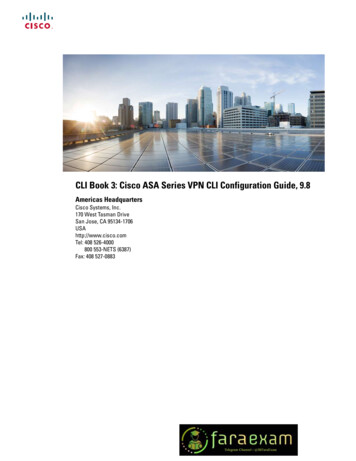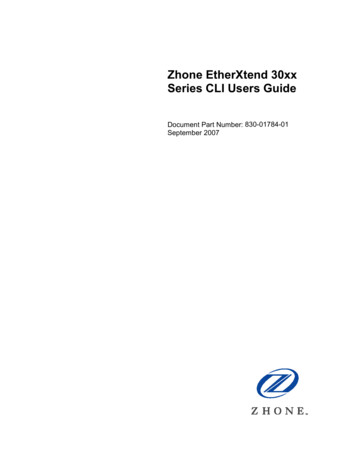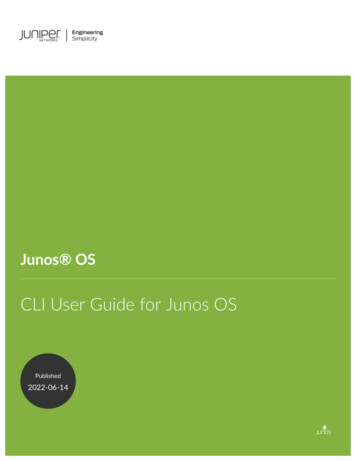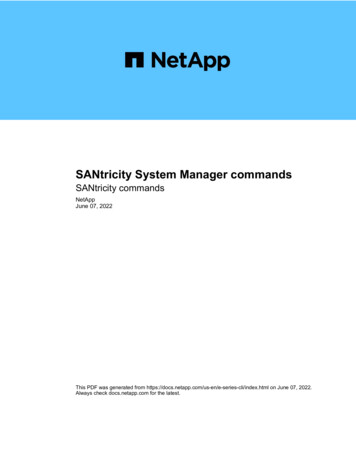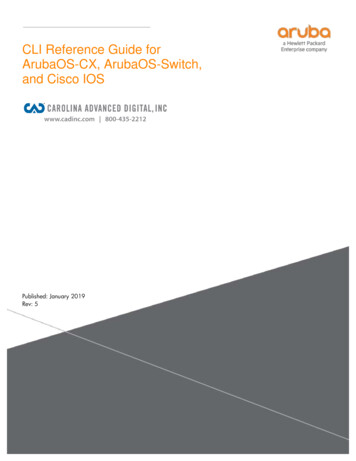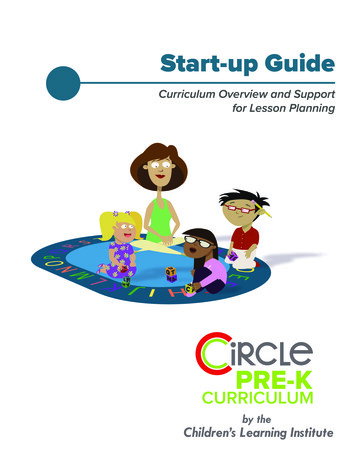
Transcription
Start-up GuideCurriculum Overview and Supportfor Lesson Planning
Children’s Learning InstituteMcGovern Medical School at UTHealth7000 Fannin Street Suite 2300 Houston, Texas 77030E: CLIsolutionsgroup@uth.tmc.eduW: CLIsolutionsgroup.org 2020 The University of Texas Health Science Center at Houston. All rights reserved.
CIRCLE Pre-K Curriculum OverviewThe CIRCLE Pre-K Curriculum Features:coverage of skill domains supporting cognitive and social and emotional· Comprehensivedevelopment· Balance of teacher-directed lessons and child-initiated activities· Daily playful and purposeful experiences across whole group, small group, and center time· Lesson scripting that follows a teaching and learning cycleTheme Guides for building language and background knowledge through· Flexiblemeaningful and relevant experiences· Scaffolds and teacher tips for modifying lessons· Authentic videos of lessons in action (available through the online CIRCLE Activity Collection)· English and Spanish versionsCURRICULUM COMPONENTSThe CIRCLE Pre-K Curriculum is comprised of a variety of resources designed to support yourweekly planning and delivery of instruction.· Scope and Sequences· Theme Guides· Supplemental resourcesThe CIRCLE Pre-K Curriculum includes Scope and Sequences and Theme Guides for addressingall aspects of the prekindergarten day throughout the school year. These components aresupported by a comprehensive bank of high-quality lessons housed in the CIRCLE ActivityCollection (CAC) on CLI Engage. Lessons are scripted, providing guidance for teachers to movethrough a cycle of modeling, guided practice, and independent practice. Many of the lessons areaccompanied by videos showing demonstrations of the lessons in authentic settings. Lessonsalso include Teacher Tips, which provide ideas for extensions and changes, and Scaffolds,which suggest ways to adjust lessons based on children’s individual needs. These ideas for 2020 The University of Texas Health Science Center at Houston. All rights reserved.1
how to differentiate instruction help teachers deliver lessons that are appropriate and targeted forthe children in their group or class, whether children are three- or four-years-old, or need morefoundational or more advanced support.The Scope and Sequences and Theme Guides work together to provide weekly instruction thatcomprehensively supports the cognitive, social, and emotional development of prekindergartenchildren. As teachers use these resources to plan lessons for a week, they have the ability to selectfewer lessons to teach, and to adjust how quickly they move from one week of content to the next.This flexibility will be especially helpful for teachers with more three-year-olds, who may movethrough the curriculum more slowly, and for teachers of half-day programs, who will include fewerof the curriculum components in their lesson plans.SCOPE AND SEQUENCE: The Scope and Sequence is the primary curriculum component. Itaddresses skills in a sequence that ensures progression of skills across the school year. The Scopeand Sequences cover 35 weeks of instruction. Lessons are organized into the following categorieswith other skill domains integrated:WEEK 3Whole Group & Small GroupWhole Group & Small GroupBook & Print ReadingPhonological AwarenessLanguage & CommunicationTarget LessonsTarget LessonsTarget LessonsFocus: Add new words to speakingvocabulary. Use the classroom library andhandle books with care. Retell stories readaloud.Acting Out WordsCaring for BooksRead Aloud RetellSee Theme Guide for read aloud titles.TPG I.B.1.b., II.D.1., II.D.5., III.D.1., III.A.2.Focus: Separate sentences into individualwords.Listening for WordsSentence HopscotchWord TossTPG III.B.1., IX.A.2.See Scafolding and Teacher Tipsnoted on lessons.Focus: Recognize names and other familiarprint in the environment. Read a rhyme whileattending to concepts of print.Willoughby Wallaby WooWhole Group & Small GroupSentence Strip Name BookLook for many opportunities during theday to engage children in talk. Strive tohave a minimum of one back-and-forthconversation with every child by theend of the week.Address a variety of letters inmeaningful, playful ways throughoutthe day, every day.TPG III.C.1. 2020 The University of Texas Health Science Center at Houston. All rights reserved.WEEK 3ScienceTarget LessonsTarget LessonsFocus: Rote count 1–5. Count 1–3 withone-to-one correspondence. Organize datain graphs.People Write in Different WaysCounting Throughout the DayModeled Daily NewsCounting TransitionsMorning MessageNumber Line DanceSkywritingYes or No GraphsTPG V.A.1., V.A.2., V.A.3., V.A.5., V.E.2.Shared Daily NewsReturn to the Daily News and MorningMessage to allow children to reread thewriting and add illustrations that matchthe message.Step It Up!One Little, Two LittleBased on children’s current countingskills, go beyond numbers 1–5 usingthe Target Lessons.TPG V.A.4., VIII.B.1.TPG IV.B.1., IV.B.3.Additional LessonsSkywriting—LinesAdditional LessonsWhat’s the Same?Skywriting—Curves and Circles3Whole Group & Small GroupMathematicsStep It Up!Additional LessonsHear It, Say ItWritingTPG IV.A.1., IV.B.1.TPG III.C.1, III.C.2, III.C.3.Additional LessonsTarget LessonsFocus: Value diferent ways of writing(e.g., scribble-like marks, symbols, pictures).Engage in model writing experiences.Social & Emotional DevelopmentTarget LessonsFocus: Regulate behavior according to therules of a game. Use kind words and actionsto make a new friend. Learn about others’likes and perspectives.Focus: Use a balance to compare theweights of objects.Using a BalanceHand-Off: Hot PotatoIncorporate theme related objects whenteaching Using a Balance. Children’sinteractions with the objects in thislesson will create opportunities to hearand use object names in meaningfulways. Refer to the I’m Me! I’m Special!Theme Guide for ideas.TPG V.D.3., VI.A.3.Making FriendsOur FavoritesContinue to review classroom rules andprocedures. Consistently use EquitySticks and Partner Talk to make thema routine part of instruction.TPG I.A.2., I.B.1.a., I.B.1.c., I.B.2.c., I.C.7., I.D.1.,II.A.1., II.A.3., II.B.1.,IX.A.2.EL TPG II.A.3.Review, Repeat, AdaptEvery child is unique, and every class or group of studentsis diferent. Customizing support for diverse learners andspecial populations is critical to ensure the success of allstudents. Based on formal and informal assessments ofstudents’ needs, teachers should review, repeat, and adaptlessons (from this week or a previous week) with studentswho need additional support. Refer to the Scafolding andTeacher Tips noted in activities for ways to modify lessonsfor understanding and mastery.Family EngagementThe following hands-on family activities complement and support skillsaddressed in the classroom this week.Name Hopscotch / Rayuela con nombresFamilies playfully interact with children to increase familiarity withthe letters in their child’s name and the spelling of their child’s name.Skywriting lines, curves, and circlesis an engaging way to familiarizechildren with the vocabulary andmotions associated with letter featuresand formations.TPG IV.A.1.Words We Know Alphabet BookTPG II.A.1., II.D.4.TPG III.B.6. 2020 The University of Texas Health Science Center at Houston. All rights reserved.WEEK 3Step It Up!Step It Up!TPG II.A.1., II.C.1, II.D.1., X.A.1., X.A.3.Rhyme Time TransitionRepeat Letter Introduction Routinewith each featured letter.TPG II.C.3., III.C.1, III.C.2, III.C.3., IV.C.2.EL TPG II.C.3.TPG II.B.3., II.C.1, II.D.1.Pictures Need a Thousand WordsLittle Red Box2Prompt children to engage in partnertalk during Question of the Day andother circle time and small groupexperiences.Word SquaresEnvironmental Print Interactive ChartTPG II.C.3., III.A.3., III.C.1., III.E.2.EL TPG II.C.3.Find the SoundGuess the VoiceAdditional LessonsAlphabet Hokey PokeyFeatured Letters: Mm, Ss, KkLetter Introduction RoutineMove to WordsTPG III.B.1.Focus: Name, recognize, and producesounds for letters.Grab BagQuestion of the DayStep It Up!Additional LessonsAlphabet KnowledgeTarget LessonsFocus: Practice answering questions andengage in conversation. Use descriptivevocabulary. Listen to and identify locationsof sounds.Toss and TellChildren enjoy hearing their names.Use children as the subject ofsentences. For early instruction andpractice, plan sentences with onlytwo to four words.Step It Up!4WEEK 3TPG V.E.1., VI.A.1. 2020 The University of Texas Health Science Center at Houston. All rights reserved.Pet Care / Cuidado de mascotasFamilies use a stufed animal to practice caring for a petand its needs. 2020 The University of Texas Health Science Center at Houston. All rights reserved. 2020 The University of Texas Health Science Center at Houston. All rights reserved.52
· Book and Print Reading· Phonological Awareness· Language & Communication· Alphabet Knowledge· Writing· Mathematics· Science· Social & Emotional DevelopmentSee the Teacher’s Manual for detailed information on each of the above categories to learn theskills addressed and the progression of skills.The Scope and Sequence indicates the names of lessons designated for the week. Lesson namesare always indicated in colored font. You can view the detailed lesson at CLIEngage.org or in theprinted Scope and Sequence book.Whole Group & Small GroupWritingTarget LessonsFocus: Value diferent ways of writing(e.g., scribble-like marks, symbols, pictures).Engage in model writing experiences.Target LessonsCounting Throughout the DayModeled Daily NewsCounting TransitionsMorning MessageNumber Line DanceSkywritingYes or No GraphsTPG V.A.1., V.A.2., V.A.3., V.A.5., V.E.2.Step It Up!Shared Daily NewsReturn to the Daily News and MorningMessage to allow children to reread thewriting and add illustrations that matchthe message.The children will experience being writers using a variety of appropriate methods.Head StartAlignmentFocus: Rote count 1–5. Count 1–3 withone-to-one correspondence. Organize datain graphs.People Write in Different WaysTPG IV.A.1., IV.B.1.People Write in Diferent WaysMathematicsWritingWEEK 3Step It Up!One Little, Two LittleBased on children’s current countingskills, go beyond numbers 1–5 usingthe Target Lessons.Goal P-LIT 6. Child writesfor a variety of purposesusing increasinglysophisticated marks.PreK GuidelinesAlignmentIV.A.1. Child intentionallyuses marks, letters,or symbols to recordlanguage and verballyshares meaning.Kindergarten TEKSAlignment§110.2(b)(2)(E) develophandwriting by accuratelyforming all uppercaseand lowercase lettersusing appropriatedirectionality.Note:Lessons names areindicated on the Scopeand Sequence. Fullydetailed lessons areavailable at CLIEngage.org and in the printedScope and Sequencebooks.Materials easel and chart papermarkersindividual dry erase boards or paperdry erase markers or pencils/crayonsPreparationHave an easel with chart paper prepared to model activity. Have individual dry erase boardand marker, or pencil and paper, ready for guided practice.ntroduceTPG V.A.4., VIII.B.1.TPG IV.B.1., IV.B.3.Additional LessonsSkywriting—LinesAdditional LessonsWhat’s the Same?“Anytime that you write a story or a message to a friend, you are being a writer. Everybodyin our class writes in diferent ways to share what they are thinking. Today we are goingto talk about all of the diferent ways that people write.”Model and Explain“Sometimes people write like this to share their stories.” Draw lines and circular scribbles.“Sometimes people write like this to share their stories.” Draw a simple picture.“Sometimes people write like this to share their stories.” Draw using letter strings.“No matter how we write, we are all authors!”Skywriting—Curves and CirclesSkywriting lines, curves, and circlesis an engaging way to familiarizechildren with the vocabulary andmotions associated with letter featuresand formations.Guide Practice“I am going to choose a few friends to come up and share with us how they write. Youmay not get a turn right now, but remember that when you go to centers you can write onyour own!” Use equity sticks or choose a child you know will be comfortable writing in frontTPG V.E.1., VI.A.1.TPG IV.A.1. 2020 The University of Texas Health Science Center at Houston. All rights reserved.463 2020 The University of Texas Health Science Center at Houston. All rights reserved.The flexible design of the Scope and Sequence allows you to select the day of the week andsetting (whole or small group) for each lesson. Lessons can be used multiple times across the weekas concepts are introduced, practiced, and reinforced. You determine which lessons to repeat andthe number of times. The table below describes the three categories of lessons indicated on theScope and Sequence.Target LessonsUse each Target Lesson with all children one or more times during theweek to ensure skill coverage and progression. Repeat lessons acrossthe week as needed or desired.Step It UpUse these optional lessons with children who might benefit from morechallenging tasks than those included in the Target Lessons.Additional LessonsAdditional Lessons are Target Lessons from previous weeks in thecurriculum. Use these optional lessons to address a greater range ofskills and to revisit previously taught lessons. Repeat lessons across theweek as needed or desired. 2020 The University of Texas Health Science Center at Houston. All rights reserved.3
A Family Engagement section is also included in every Scope and Sequence. These activitiescan be provided to families as a way to enhance the family-school partnership and encouragefamilies to engage in playful learning experiences. Through these activities, families becomeinvolved in supporting the skills children are learning that week in school. Learn more in the FamilyEngagement section of this Teacher’s Manual.THEME GUIDE: Theme Guides work in partnership with the Scope and Sequence to organizemeaningful, hands-on lessons and experiences around a common theme. While the Scope andSequence ensures systematic coverage of all skill domains, the Theme Guide enhances the Scopeand Sequence. Each theme is designed to address concepts and experiences that build importantbackground and content area knowledge. In addition to supporting the skill domains from theScope and Sequence, Theme Guides address:· Fine Arts· Physical Development· Social Studies· TechnologyUsing a Theme Guide in conjunction with the Scope and Sequence ensures comprehensivecoverage of all skill domain areas while addressing all aspects of the prekindergarten schedule.Within each theme is a set of topics, or subthemes. Each topic addresses approximately one weekof activities and lessons for all aspects of the prekindergarten day. Topics are flexible, allowingteachers to spend more or less than one week on a topic, if desired.Welcome to Pre-K! is an integrated Scope and Sequence and Theme Guide designed specificallyto addresses the particular needs of young children during the first two weeks of prekindergarten.Integrated Scope andSequence and Theme GuideTopicsWeeksMy SchoolWeek 1My FriendsWeek 2Welcome to Pre-K! 2020 The University of Texas Health Science Center at Houston. All rights reserved.4
Beginning with week 3 of school, teachers can use themes in any order or follow the suggestedsequence provided below.ThemeTopicsScope &SequenceI’m Me! I’m Special!My Home and FamilyMy Amazing BodyMy Five SensesMy Important FeelingsWeeks 3-6All Around My CommunityPlaces in My CommunityPeople and Jobs in My CommunityGetting Around in My CommunityConstruction in My CommunityWeeks 7-10It’s Harvest Time!Signs of Fall HarvestHarvesting CropsBringing the Harvest HomeWeeks 11-13The Sky Above MeThe Cloudy SkyThe Sunny SkyThe Night SkyThe Seasonal SkyWeeks 14-17Animals All AroundAnimal Bodies and MovementsAnimal Homes and HabitatsAnimal Babies and DietsAnimal Adaptations and HabitsWeeks 18-21I’m Healthy! I’m Safe!My Safe and Active BodyMy Safe and Healthy Eating HabitsMy Healthy Body and TeethWeeks 22-24Get Moving!Moving Through AirMoving on LandMoving on WaterWeeks 25-27The Earth Around MeLand All AroundPlants All AroundWater All AroundCaring All AroundWeeks 28-31Creepy Crawly CrittersCritter Bodies and MovementsCritter Homes and HabitatsCritter Life Cycle and DietCritter Adaptations and HabitsWeeks 32-35 2020 The University of Texas Health Science Center at Houston. All rights reserved.5
Theme Guides are organized into three sections to support lesson planning and implementation.The three sections are described below.Whole Group andSmall Group ThemeLessonsAdditional whole group and small group lessons which may not beincluded in the Scope and Sequence. These supplemental lessonsappear in the Theme Guide because they directly connect to themeconcepts.Theme ExtendersSuggestions for ways to integrate theme vocabulary, read aloud books,and activities with the Scope and Sequence activities and lessons.Learning CentersRecommendations for adding thematic materials and activities tosupplement or replace your classroom’s existing center materials andactivities.Like the Scope and Sequence, the Theme Guide indicates the names of lessons designated forthe topic. Lesson names are always indicated in colored font. You can view the detailed lesson atCLIEngage.org or in the printed Theme Guide book.Me and My Amazing Body2Children will learn the names of body parts and what they do by listening to a read aloud.My Amazing BodyHead StartAlignmentEssential Ideas:Goal P-SCI 1. Childobserves and describesobservable phenomena(objects, materials,organisms, and events).body grows and changes. Myimportant parts on the inside and outside of my body. IMyhavebody is the same as others’ bodies, but it is also diferent. Germscan make my body sick. PreK GuidelinesAlignmentVI.B.1. Child observes,investigates, describesand discusses thecharacteristics oforganisms.IX.C.2. Child practicesgood habits of personalhealth and hygiene.Note: This topic is focused on building a general understanding of the body. Germs havebeen included within this topic to set the stage for good personal hygiene while at school.Later, you will fnd the theme I’m Healthy! I’m Safe! This theme will go into greater depthabout caring for our bodies.Whole Group & Small Group Theme essonsKindergarten TEKSAlignment§115.2(b)(4)(B) name majorbody parts and theirfunctions§116.2(b)(2)(A) identifyselected body parts suchas head, back, chest,waist, hips, arms, elbows,wrists, hands, fngers,legs, knees, ankles, feet,and toesMaterials book about the body (see suggested titles below)Select from these whole and small group lessons to supplement those indicated on theScope and Sequence.My Body by Jill McDonaldMy Body/Mi cuerpo by Gladys Rosa-MendozaAlphabet KnowledgeName SortTPG III.C.1.anguage & Communication Teddy Bear, Teddy BearTo support children learning English,pre-teach the English instructionsfor body movements, modeling andhaving the children practice.TPG II.A.2., IX.A.2.EL TPG II.A.2.Scholastic Discover More: My Body/Scholastic explora tu mundo: Mi cuerpo by AndreaPinningtonPhysical DevelopmentGerms, Germs, Germs: This activity includesa nonfiction read aloud about From Head to Toe/De la cabeza a los pies by Eric Carlegerms. The book Germs! Germs! Germs!by Bobbi Katz is suggested.Model and practice good habits ofpersonal health to use in the classroomand at home.Examples: cough and sneeze into elbow,wash hands after using the restroomPreparationNoneirectionsBefore readingTPG IX.C.2.“Today we are going to read a book about our bodies. The name of our book is . Inthis book, we’re going to learn about the important parts of our body. Listen to see if youcan fnd the diferent body parts.”Science Me and My Amazing Bodydifferent body parts with Brainstormchildren, and have them draw the 2020 The University of Texas Health Science Center at Houston. All rights reserved.2942 2020 The University of Texas Health Science Center at Houston. All rights reserved.Refer to the Them Guide Overview section on the Theme Guide curriculum website page or atthe front of each printed Theme Guide for additional information to support implementation ofparticular themes.SUPPLEMENTAL RESOURCES: Some lessons use picture cards or workmats that may be includedwith the curriculum materials. Digital curriculum users can download and print these supplementalresources using the download PDF link within the lesson. Users of the print curriculum receivethese print resources as companions to the Scope and Sequence books. In the event thatsupplemental resources are lost or damaged, additional copies are available for download andprint by visiting the digital lessons at CLIEngage.org.Some lessons require materials not included as supplemental resources. In these cases, directionsare provided for creating the resource. 2020 The University of Texas Health Science Center at Houston. All rights reserved.6
Understanding IconsIdentifies lessons with English video demonstrations. Visit the digital lesson in the CIRCLEActivity Collection at CLIEngage.org to view these lessons in action with children.Identifies lessons with Spanish video demonstrations. Visit the digital lesson in the CIRCLEActivity Collection at CLIEngage.org to view these lessons in action with children. English videosmay be available when Spanish videos are not. To view the lesson in English, visit the Spanishdigital lesson, then click the “View Activity in English” button.Indicates lessons recommended for use in a small group setting. Most lessons are appropriatein either whole group or small group settings. Teachers determine the setting based onchildren’s needs, materials, and classroom management considerations.Indicates notes or tips for preparing and delivering lessons or activities.Reminds you to always select and use a Theme Guide in conjunction with this Scope andSequence.Indicates songs and rhymes found in The Complete Book of Rhymes, Songs, Poems,Fingerplays, and Chants by Jackie Silberg and Pam Schiller for English curriculum users or inThe Bilingual Book of Rhymes, Songs, Stories, and Fingerplays por Pam Schiller, Rafael LaraAlecio, y Beverly J. Irby for Spanish curriculum users. Most songs and rhymes can also be foundthrough an online search.LESSON PLANNINGThis section provides lesson planning guidance for new users of the curriculum. A teacher’sapproach to lesson planning is a unique process informed by a variety of factors, including the dailyschedule and children’s developmental needs. Curriculum components flexibly meet the needsof full- and half-day prekindergarten programs, as well as those serving three- and four-year-oldchildren.The Scope and Sequence and Theme Guide are used together to comprehensively plan howchildren will engage in whole group (circle time), small groups, and centers during a week. Teacherscan easily plan for a full-day schedule, while the flexible design allows half-day programs toselect fewer lessons and activities when planning. To address the different developmental andinstructional needs of the children, teachers can select from Target Lessons, Additional Lessons,and Step It Up! lessons. Within each lesson, Teacher Tips can adjust or extend the activity andScaffolds can simplify the task or support understanding. Teachers should plan each week usingthe flexible features of the Scope and Sequence and Theme Guide to meet the specific needs ofthe children in the class.Steps for PlanningStep 1: Gather Materials1. Scope and Sequence for the week you are planning—for example, use the Week 3 Scopeand Sequence for the third week of the year2. Theme Guide—a recommended theme sequence is included in the Theme Guide sectionof this Start-up Guide3. Any preferred lesson plan document or tool—a sample template is included to use ormodify as needed4. Assessment data—formal and informal data are critical considerations throughout theplanning process and should be considered in each step 2020 The University of Texas Health Science Center at Houston. All rights reserved.7
Step 2: Review Scope and Sequence LessonsIdentify the skills addressed this week. Look at the lessons indicated in colored font and brieflyreview the detailed/scripted version of each lesson. For each lesson, determine the following:Will I use the lesson?·Note: Use of all Target Lessons ensures comprehensive skill coverage and progression. Lessons inthe Step It Up! and Additional Lessons sections are optional.If you will use the lesson:Will the lesson be used with all children or only some children?Will the lesson take place in whole group or small group(s)?···Step 3: Plan using the Scope and SequenceAdd Scope and Sequence lessons to your lesson plan according to decisions made in Step 2.Step 4: Review Theme Guide Lessons and ActivitiesReview the three sections for the Topic: 1) Whole Group and Small Group Theme Lessons, 2) ThemeExtenders, and 3) Learning Centers.Determine the following:Will I use the lesson or activity?If so, will it take place in whole group or small group(s)?Note: Demonstrate center activities during whole group or small group(s) before adding tocenters.··Step 5: Plan using the Theme GuideAdd Theme Guide lessons and activities to your lesson plan according to decisions madein Step 4.Document any adaptations you will make to Scope and Sequence lessons in order toincorporate the theme into your lessons.··Step 6: Review and ReflectReview the lesson plan carefully to ensure all components of the school day have been addressed.For example:Are all learning domains addressed?Is each component of the daily schedule accounted for?Is it necessary to back up to earlier lessons for any skills?Note: This may apply to the whole class, or particular children who may benefit fromtargeted small group instruction.Have you determined which transitions you will use?Do you know what books and materials are needed?·····These steps provide a general overview of how to use each component of the CIRCLE Pre-KCurriculum to plan for a week of instruction. Effective planning is a detailed process that includesplanning for teacher-led and child-initiated experiences, preparing and gathering materials, andadjusting the physical environment to support language and learning.Themes are most successful when teachers begin to plan for them in advance. Identify yourupcoming theme and carefully review the Theme Guide to identify resources and materials thatmay take time to gather or prepare. Theme Guides offer detailed information to support effectiveimplementation. 2020 The University of Texas Health Science Center at Houston. All rights reserved.8
Lesson Planning Appendix
Mr. PlanfulMonday How I Feel RightNow/Homeschool sign-in Check helperchart Daily schedule Partner Talkabout favoriteanimal18Lesson PlanTuesdayWednesday How I Feel Right How I Feel RightNow/HomeNow/Homeschool sign-inschool sign-in Check helper Check helperchartchart Daily schedule Daily schedule Question of the Our FavoriteDay w/ PartnerSongs andTalk: Have youRhymes: Displayever touched a2 poem chartslizard?from pastthemes. Vote bySocial & Emotional DevelopmentTPG I.A.2., I.B.1.a., I.B.2.b., I.B.2.a.,I.B.2.c., I.D.1.a., II.B.4., II.D.4.1. Understand feelings have di erentlevels and fuctuate2. Identify when to manage feelingsWritingTPG I.B.2.b., IV.A.1., IV.B.1., IV.C.2.,IV.C.4.1. Write about personal experiencesEngage in and contribute to sharedwritingFocus SkillsPhonological AwarenessTPG III.B.5.1. Segment words into syllablesS&SWeek: 2020 The University of Texas Health Science Center at Houston. All rights reserved.Morning ArrivalRoutine(10 min)Learning BlocksTPG VI.B.1.1. Identify and compare animals by shapeand size2. Understand animals have di erentcoverings and body parts to help themsurviveScienceAlphabet KnowledgeTPG III.C.1, III.C.2, III.C.3.1. Name, recognize, and produce soundsfor lettersBook & Print ReadingTPG II.D.2., II.D.4., II.D.5., III.A.1., III.D.1.,III.D.3., IV.C.2., VII.D.3. EL TPG II.D.6.1. Think about self-generated textquestions2. Retell songs and rhymes3. Learn new vocabulary from booksTeacher:Animals All Around –Topic 1Thursday How I Feel RightNow/Homeschool sign-in Check helperchart Daily schedule Question of theDay with PartnerTalk: Do youhave a pet?10Friday How I Feel RightNow/Homeschool sign-in Check helperchart Daily schedule Partner Talkabout newanimal learnedthis weekMathematicsTPG V.A.1., V.A.3., V.A.8., V.B.1.1. Rote count to 202. Count 1-10 objects with one-to-one3. Add 0-3 objects4. Subitize 0-3 objectsSocial StudiesTPG VII.B.3.Understand the job of a veterinarianand clinic sta Language & CommunicationTPG I.C.1., II.A.2., II.B.3., II.D.4., VIII.A.1.,IX.A.2., IX.B.1. EL TPG II.A.2.1. Demonstrate understanding of newvocabulary2. Listen and repeat series ofdirections3. Answer questions in conversationThemeGuide:
Poem: “GraySquirrel” (in songbook) Model usingsquirrel pointerto read poemwith pictures onchart paper.Includemovements. Use equitysticks to selectchildren to retell Add toClassroomLibraryDrawing withDetails Decide thedrawing as agroup byprompting topick an animaland tell itscovering andother featuresABC & Name Games - If Your Name Starts With or Where is My Name (in week 16 S&S)Show/name aWrite about a time Detailed drawingWrite about a time Detailed drawingvariety of animals you saw an animal about a time youyou were able toabout a time youusing pictures.outside yoursaw an animal’spet a cat or other played withDraw a favoritehouse.tongue.pet.student of theanimal on smallEncourageweek - Marcus.paper square,thinking throughEncouragewrite name, andthe drawing asthinking throughplace in basket formodeled bythe drawing asmath graph. Writeteacher.modeled byin journal aboutteacher.animal if timeallows. 2020 The University of Texas Health Science Center at Houston. All rights reserved.Journals(5-10 min)Transition/MovementCircle Time(10-20 min)Writing & ReadingTransition/Movementplacing a smallsticky note onfavorite. Count
Children's Learning Institute McGovern Medical School at UTHealth 7000 Fannin Street Suite 2300 Houston, Texas 77030 . E: CLIsolutionsgroup@uth.tmc.edu
